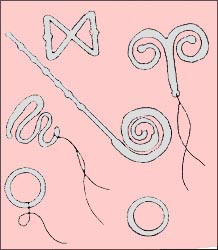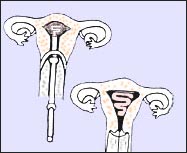

Copyright ⓒ 2014 John Sangwon Lee, MD., FAAP
Intrauterine contraceptive devices 자궁강 내 피임장치

Different types of intrauterine contraceptive devices
![]()
A contraceptive device can be placed in the uterine cavity to provide contraception. There are several intrauterine contraceptive devices.
Most intrauterine contraceptive devices are made of plastic or metal.
The intrauterine contraceptive device can be easily removed when the contraceptive is no longer needed, or when side effects occur with the intrauterine contraceptive device. When the intrauterine contraceptive is no longer needed, a nylon thread is attached to the intrauterine contraceptive so that the contraceptive can be easily removed.
Depending on the size and shape of the uterus, the shape and size of the intrauterine contraceptive device are also slightly different.
These days, intrauterine contraceptive devices such as Dalkon shied and Lippe loop are commonly used. Sometimes, contraception with an intrauterine contraceptive device may be more effective in contraception in adolescent girls than with oral contraceptives.
It is still unclear how contraceptives are used when contraceptives are given with an intrauterine contraceptive device, but it is said that the fertilized egg with the intrauterine contraceptive device prevents implantation on the inner wall of the uterus and is thus contraceptive.
The intrauterine contraceptive device does not cause uterine cancer and does not permanently damage the inner wall of the uterus.
There are no systemic side effects, nor does it interfere with the ovulation of the egg in the ovary.
During menstruation, the cervical canal is wider than usual and the pregnancy is not, so it is common to use an intrauterine contraceptive device during menstruation.

The loop is a type of contraceptive device in the uterine cavity.
![]()
The loop can be placed in the uterus as follows: After straightening the winding loop into the loop insertion tube, push one end of the loop insertion tube through the cervix into the uterine cavity, and remove only the loop insertion tube to insert the loop.
Since part of the nylon thread connected to the loop is in the vagina, you can remove the loop by pulling the nylon thread as needed. Loop device in the uterine cavity When contraceptive with the intrauterine contraceptive device, the contraceptive effect is slightly different depending on the type of intrauterine contraceptive device. In general, the contraceptive effect is about 97%.
Side effects that can occur with intrauterine contraceptives include: Your belly can hurt little by little, and your uterine bleeding can be excessive during menstruation. Hemorrhage in the uterus can occur little by little at any time.
Very rarely, an intrauterine contraceptive device is in the uterus, which can lead to pregnancy. Intrauterine contraceptive devices can infrequently develop uterine infections and perforation of the uterus.
When the intrauterine contraceptive device does not fit the body physiologically, the uterus contracts abnormally and the intrauterine contraceptive device prolapses out of the uterus. Before using an intrauterine contraceptive device, you should carefully understand the advantages and disadvantages of the method before deciding to use this method. Copyright ⓒ 2014 John Sangwon Lee, MD., FAAP
“부모도 반의사가 되어야 한다”-본 사이트의 내용은 여러분들의 의사로부터 얻은 정보와 진료를 대신할 수 없습니다.
“The information contained in this publication should not be used as a substitute for the medical care and advice of your doctor. There may be variations in treatment that your doctor may recommend based on individual facts and circumstances.
“Parental education is the best medicine.“